|
|
#641 |
|
⊙▃⊙
|
What's in the sky tonight?
August 16, 2013 -Antares is lower right of the Moon this evening. -The US Air Force Space Surveillance System, a.k.a. the "Space Fence," will be shut down on Oct. 1st. This is a result of automatic cuts imposed by the US Congressional budget sequester. The Space Fence is a multi-station radar deployed across the southern USA capable of tracking satellites, space debris, and meteoroids as far as 30,000 km from Earth. This negatively impacts Space Weather Radio as well, which broadcasts echoes from the Space Fence. In October, spaceweather's radio will shift to a new type of meteor radar based on the forward scattering of VHF TV signals. News Posted Today: August 14, 2013 Bright Nova in Delphinus  Astro Picture of the Day: August 15, 2013 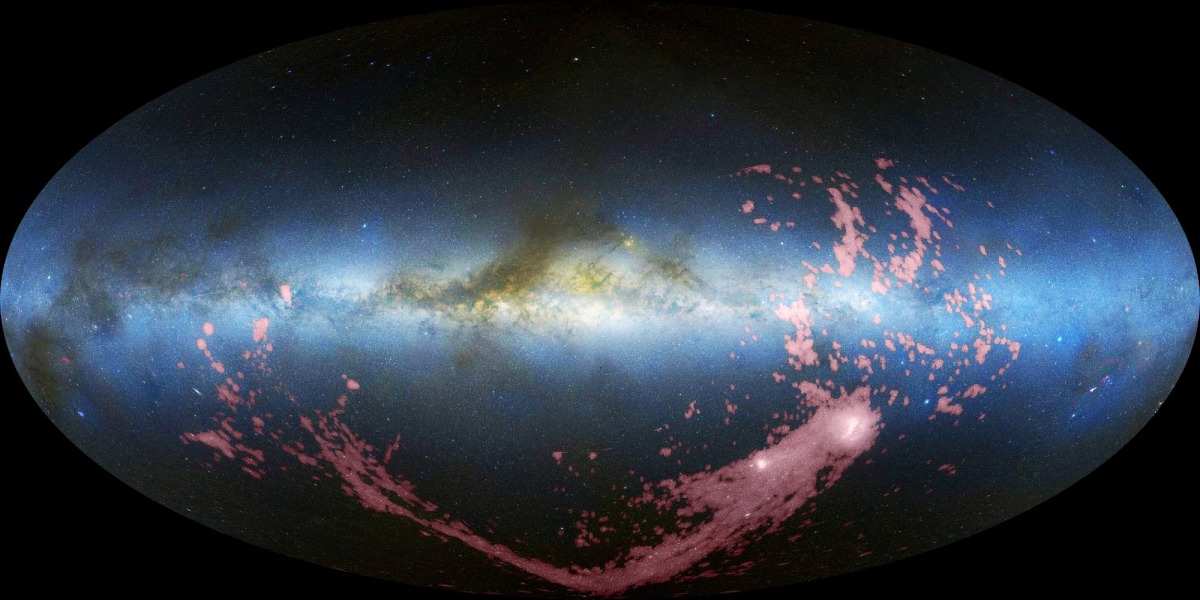 In an astronomical version of the search for the source of the Nile, astronomers now have strong evidence for the origin of the Magellanic Stream. This composite image shows the long ribbon of gas, discovered at radio wavelengths in the 1970s, in pinkish hues against an optical all-sky view across the plane of our Milky Way galaxy. Both Large and Small Magellanic Clouds, dwarf satellite galaxies of the the Milky Way, are seen near the head of the stream at the right. Data from Hubble's Cosmic Origins Spectrograph were used to explore abundances of elements along sitelines to quasars that intersect the stream. The results indicate that most of the stream's material comes from the Small Magellanic Cloud. The Magellanic Stream is likely the result of gravitational tidal interactions between the two dwarf galaxies some 2 billion years ago, the Small Magellanic Cloud losing more material in the encounter because of its lower mass.
__________________
1st in Kommisar's 2009 SM Tournament 1st in I Love You`s 2009 New Year`s Tournament 3rd in EnR's Mashfest '08 tournament 5th in Phynx's Unofficial FFR Tournament 9th in D3 of the 2008-2009 4th Official FFR Tournament 10th in D5 of the 2010 5th Official FFR Tournament 10th in D6 of the 2011-2012 6th Official FFR Tournament FMO AAA Count: 71 FGO AAA Count: 10 Bluearrowll = The Canadian player who can not detect awkward patterns. If it's awkward for most people, it's normal for Terry. If the file is difficult but super straight forward, he has issues. If he's AAAing a FGO but then heard that his favorite Hockey team was losing by a point, Hockey > FFR PS: Cool AAA's Terry - I Love You An Alarm Clock's Haiku beep beep beep beep beep beep beep beep beep beep beep beep beep beep beep beep beep - ieatyourlvllol Last edited by Bluearrowll; 08-16-2013 at 06:03 AM.. |
|
|

|
|
|
#642 |
|
⊙▃⊙
|
What's in the sky tonight?
August 16, 2013 -By about 10 p.m. (depending on where you live), W-shaped Cassiopeia is now as high in the northeast as the Big Dipper is in the northwest. Cassiopeia will grow ever more ascendant over the Dipper for the next several months as the seasons turn. -The nova discovered in Delphinus on Wednesday brightened to magnitude 5.2 in hardly more than 24 hours. Delphinus is conveniently high in the evening sky. The nova is easy to see in binoculars, and it's faintly visible to the naked eye if you have a dark sky.  News Posted Today: August 15, 2013 New Pulsar Explores Heart of Milky Way  Astro Picture of the Day: August 16, 2013 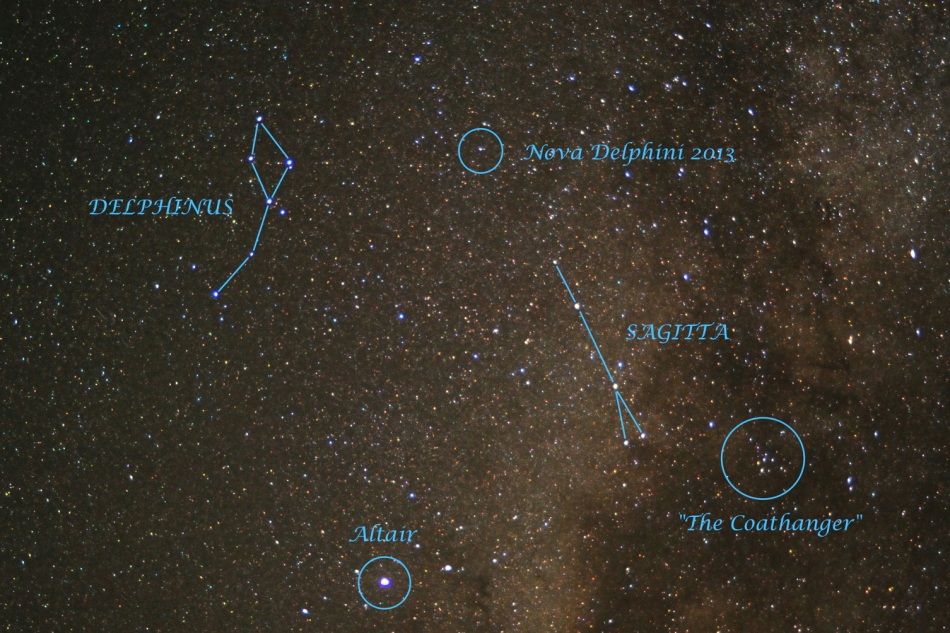 Using a small telescope to scan the skies on August 14, Japanese amateur astronomer Koichi Itagaki discovered a "new" star within the boundaries of the constellation Delphinus. Indicated in this skyview captured on August 15 from Stagecoach, Colorado, it is now appropriately designated Nova Delphini 2013. Sagitta, the Arrow, points the way to the newcomer's location high in the evening sky, not far from bright star Altair and the asterism known to northern hemisphere skygazers as the Summer Triangle. The nova is reported to be easy to spot with binoculars, near the limit of naked-eye visibility under dark skies. In fact, previous deep sky charts do show a much fainter known star (about 17th magnitude) at the position of Nova Delphini, indicating this star's apparent brightness suddenly increased over 25,000 times. How does a star undergo such a cataclysmic change? The spectrum of Nova Delphini indicates it is a classical nova, an interacting binary star system in which one star is a dense, hot white dwarf. Material from a cool, giant companion star falls onto the surface of the white dwarf, building up until it triggers a thermonuclear event. The drastic increase in brightness and an expanding shell of debris is the result - but the stars are not destroyed! Classical novae are believed to recur when the flow of material onto the white dwarf resumes and produces another outburst.
__________________
1st in Kommisar's 2009 SM Tournament 1st in I Love You`s 2009 New Year`s Tournament 3rd in EnR's Mashfest '08 tournament 5th in Phynx's Unofficial FFR Tournament 9th in D3 of the 2008-2009 4th Official FFR Tournament 10th in D5 of the 2010 5th Official FFR Tournament 10th in D6 of the 2011-2012 6th Official FFR Tournament FMO AAA Count: 71 FGO AAA Count: 10 Bluearrowll = The Canadian player who can not detect awkward patterns. If it's awkward for most people, it's normal for Terry. If the file is difficult but super straight forward, he has issues. If he's AAAing a FGO but then heard that his favorite Hockey team was losing by a point, Hockey > FFR PS: Cool AAA's Terry - I Love You An Alarm Clock's Haiku beep beep beep beep beep beep beep beep beep beep beep beep beep beep beep beep beep - ieatyourlvllol |
|
|

|
|
|
#643 |
|
⊙▃⊙
|
What's in the sky tonight?
August 17, 2013 - The waxing gibbous Moon shines in the south after nightfall. Below it is the Sagittarius Teapot, as shown at right. -Look high to the Moon's upper left for bright Altair. Just above Altair is 3rd-magnitude Tarazed, an orange-red giant star (can you see its tint?) 20 times farther away. - The nova appears to have peaked a little brighter than magnitude 4.5 on August 16th. It was back down roughly to magnitude 4.8 around 10 p.m. EDT on the 16th (2h August 17th UT).  Astro Picture of the Day: August 17, 2013  The Delphinus Nova last night was visible in binoculars in even the brightest of cities in Canada, including Toronto. This composite image is a 51 picture stack of the Delphinus Nova, taken around 10;47pm EST. I was unable to spot the nova without optical aids, but it was visible through my camera lens. The bright moon had washed out a lot of the fainter objects in this area of the sky, but a satellite decided to nicely frame itself while I was taking pictures. The Nova's magnitude can be found using this link from AAVSO: http://www.aavso.org/lcg/plot?auid=0...=&mean=&vmean=
__________________
1st in Kommisar's 2009 SM Tournament 1st in I Love You`s 2009 New Year`s Tournament 3rd in EnR's Mashfest '08 tournament 5th in Phynx's Unofficial FFR Tournament 9th in D3 of the 2008-2009 4th Official FFR Tournament 10th in D5 of the 2010 5th Official FFR Tournament 10th in D6 of the 2011-2012 6th Official FFR Tournament FMO AAA Count: 71 FGO AAA Count: 10 Bluearrowll = The Canadian player who can not detect awkward patterns. If it's awkward for most people, it's normal for Terry. If the file is difficult but super straight forward, he has issues. If he's AAAing a FGO but then heard that his favorite Hockey team was losing by a point, Hockey > FFR PS: Cool AAA's Terry - I Love You An Alarm Clock's Haiku beep beep beep beep beep beep beep beep beep beep beep beep beep beep beep beep beep - ieatyourlvllol Last edited by Bluearrowll; 08-17-2013 at 11:13 AM.. |
|
|

|
|
|
#644 |
|
⊙▃⊙
|
What's in the sky tonight?
August 18, 2013 -The two brightest stars of summer are Vega, passing overhead soon after dark, and Arcturus shining in the west. Vega is a white-hot type-A star 25 light-years away. Arcturus is an orange-yellow-hot type-K giant 37 light-years distant. Both are much brighter than the Sun. Their color difference is pretty clear to the unaided eye. -Venus (magnitude –4.0) shines brightly low in the west in evening twilight, far below Arcturus. Look to its left and somewhat higher for much fainter Spica, and further on, Saturn. In a telescope Venus is still small (14 arcseconds) and gibbous (78% sunlit). Astro Picture of the Day: August 18, 2013  Skylab was an orbiting laboratory launched by a Saturn V rocket in May 1973. Skylab, pictured above, was visited three times by NASA astronauts who sometimes stayed as long as two and a half months. Many scientific tests were performed on Skylab, including astronomical observations in ultraviolet and X-ray light. Some of these observations yielded valuable information about Comet Kohoutek, our Sun and about the mysterious X-ray background - radiation that comes from all over the sky. Skylab fell back to earth on 1979 July 11.
__________________
1st in Kommisar's 2009 SM Tournament 1st in I Love You`s 2009 New Year`s Tournament 3rd in EnR's Mashfest '08 tournament 5th in Phynx's Unofficial FFR Tournament 9th in D3 of the 2008-2009 4th Official FFR Tournament 10th in D5 of the 2010 5th Official FFR Tournament 10th in D6 of the 2011-2012 6th Official FFR Tournament FMO AAA Count: 71 FGO AAA Count: 10 Bluearrowll = The Canadian player who can not detect awkward patterns. If it's awkward for most people, it's normal for Terry. If the file is difficult but super straight forward, he has issues. If he's AAAing a FGO but then heard that his favorite Hockey team was losing by a point, Hockey > FFR PS: Cool AAA's Terry - I Love You An Alarm Clock's Haiku beep beep beep beep beep beep beep beep beep beep beep beep beep beep beep beep beep - ieatyourlvllol |
|
|

|
|
|
#645 |
|
⊙▃⊙
|
What's in the sky tonight?
August 19, 2013 -Look east in early dawn for the next few mornings and spot bright Jupiter. Look lower left of Jupiter for faint Mars. Mars forms the bottom end of a curving line with similarly bright Pollux and Castor (to its upper left). Watch this line straighten out day by day as Mars speeds eastward. It becomes exactly straight on Sunday morning the 25th. Astro Picture of the Day: August 19, 2013 Why would the sky still glow after sunset? Besides stars and the band of our Milky Way galaxy, the sky might glow because it contains either noctilucent clouds or aurora. Rare individually, both are visible in the above time lapse movie taken over Caithness, Scotland, UK taken during a single night earlier this month. First noted in 1885, many noctilucent clouds are known to correlate with atmospheric meteor trails, although details and the origins of others remain a topic of research. These meandering bright filaments of sunlight-reflecting ice crystals are the highest clouds in the Earth's atmosphere. The above video captures not only a variety of noctilucent clouds, but also how their structure varies over minutes. Lower clouds typically appear dark or fast moving. About halfway through the video the clouds are joined by aurora. At times, low clouds, noctilucent clouds, and aurora are all visible simultaneously, each doing their own separate dance, and once - see if you can find it - even with the Big Dipper rotating across the background.
__________________
1st in Kommisar's 2009 SM Tournament 1st in I Love You`s 2009 New Year`s Tournament 3rd in EnR's Mashfest '08 tournament 5th in Phynx's Unofficial FFR Tournament 9th in D3 of the 2008-2009 4th Official FFR Tournament 10th in D5 of the 2010 5th Official FFR Tournament 10th in D6 of the 2011-2012 6th Official FFR Tournament FMO AAA Count: 71 FGO AAA Count: 10 Bluearrowll = The Canadian player who can not detect awkward patterns. If it's awkward for most people, it's normal for Terry. If the file is difficult but super straight forward, he has issues. If he's AAAing a FGO but then heard that his favorite Hockey team was losing by a point, Hockey > FFR PS: Cool AAA's Terry - I Love You An Alarm Clock's Haiku beep beep beep beep beep beep beep beep beep beep beep beep beep beep beep beep beep - ieatyourlvllol |
|
|

|
|
|
#646 |
|
⊙▃⊙
|
What's in the sky tonight?
August 20, 2013 -The nova peaked a little brighter than magnitude 4.5 early on August 16th, declined slightly, and then has held remarkably steady ever since. It remained a little brighter than magnitude 5.0 from 12h UT August 16th to 18h UT August 18th. -Full Moon (exact at 9:45 p.m. Eastern Daylight Time). The Moon rises around sunset and shines in dim Aquarius after dark. -According to NOAA analysts, a CME hurled into space by an M3-class solar flare on August 17th will probably miss Earth. However, Earth will pass through the wake of the CME after the cloud itself passes by. This could trigger polar geomagnetic storms despite the CME being off-target. High-latitude sky watchers should be alert for auroras on August 20-21. Astro Picture of the Day: August 20, 2013  An unusual type of solar eclipse occurred last year. Usually it is the Earth's Moon that eclipses the Sun. Last June, most unusually, the planet Venus took a turn. Like a solar eclipse by the Moon, the phase of Venus became a continually thinner crescent as Venus became increasingly better aligned with the Sun. Eventually the alignment became perfect and the phase of Venus dropped to zero. The dark spot of Venus crossed our parent star. The situation could technically be labeled a Venusian annular eclipse with an extraordinarily large ring of fire. Pictured above during the occultation, the Sun was imaged in three colors of ultraviolet light by the Earth-orbiting Solar Dynamics Observatory, with the dark region toward the right corresponding to a coronal hole. Hours later, as Venus continued in its orbit, a slight crescent phase appeared again. The next Venusian solar eclipse will occur in 2117.
__________________
1st in Kommisar's 2009 SM Tournament 1st in I Love You`s 2009 New Year`s Tournament 3rd in EnR's Mashfest '08 tournament 5th in Phynx's Unofficial FFR Tournament 9th in D3 of the 2008-2009 4th Official FFR Tournament 10th in D5 of the 2010 5th Official FFR Tournament 10th in D6 of the 2011-2012 6th Official FFR Tournament FMO AAA Count: 71 FGO AAA Count: 10 Bluearrowll = The Canadian player who can not detect awkward patterns. If it's awkward for most people, it's normal for Terry. If the file is difficult but super straight forward, he has issues. If he's AAAing a FGO but then heard that his favorite Hockey team was losing by a point, Hockey > FFR PS: Cool AAA's Terry - I Love You An Alarm Clock's Haiku beep beep beep beep beep beep beep beep beep beep beep beep beep beep beep beep beep - ieatyourlvllol |
|
|

|
|
|
#647 |
|
⊙▃⊙
|
What's in the sky tonight?
August 21, 2013 -This is the time of year when the Big Dipper scoops down during evening, as if to pick up the water that it will dump from high overhead early next spring. Look northwest. -As Earth passes through the wake of one CME, which did little to stir geomagnetic activity on Aug. 20th, another CME is on the way. NOAA forecasters expect a coronal mass ejection hurled into space yesterday by an erupting magnetic filament to deliver a glancing blow to Earth's magnetic field on Aug. 23rd. High-latitude sky watchers should be alert for auroras. Astro Picture of the Day: August 21, 2013 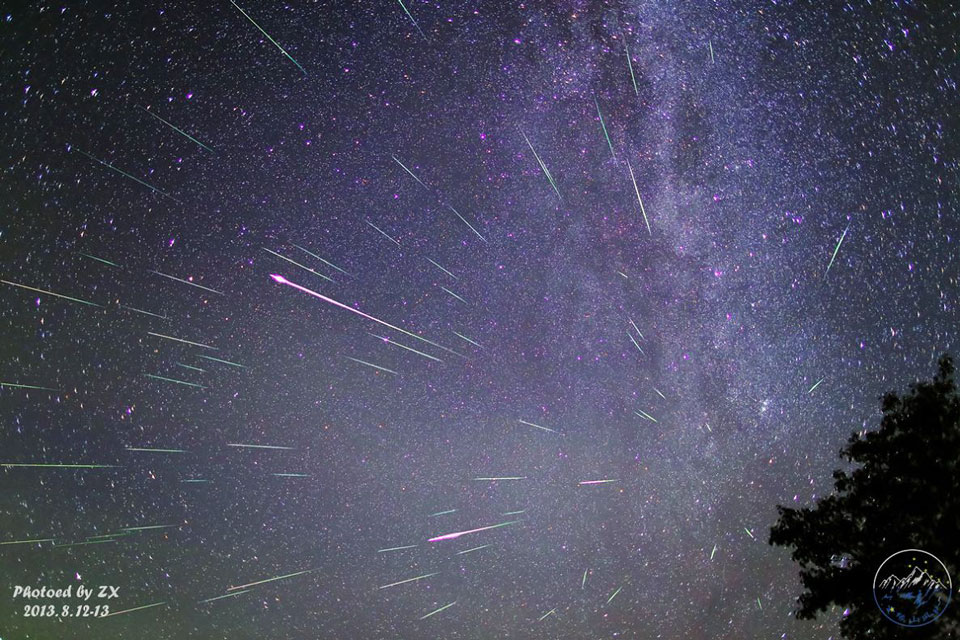 Comet dust rained down on planet Earth earlier this month, streaking through dark skies in the annual Perseid meteor shower. While enjoying the anticipated space weather above Zhangbei Prairie, Hebei Province, China, astronomer Xiang Zhan recorded a series of 10 second long exposures spanning four hours on the night of August 12/13 using a wide angle lens. Combining frames which captured 68 meteor flashes, he produced the above composite view of the Perseids of summer. Although the sand-sized comet particles are traveling parallel to each other, the resulting shower meteors clearly seem to radiate from a single point on the sky in the eponymous constellation Perseus. The radiant effect is due to perspective, as the parallel tracks appear to converge at a distance. The next notable meteor shower may be the Orionids in late October.
__________________
1st in Kommisar's 2009 SM Tournament 1st in I Love You`s 2009 New Year`s Tournament 3rd in EnR's Mashfest '08 tournament 5th in Phynx's Unofficial FFR Tournament 9th in D3 of the 2008-2009 4th Official FFR Tournament 10th in D5 of the 2010 5th Official FFR Tournament 10th in D6 of the 2011-2012 6th Official FFR Tournament FMO AAA Count: 71 FGO AAA Count: 10 Bluearrowll = The Canadian player who can not detect awkward patterns. If it's awkward for most people, it's normal for Terry. If the file is difficult but super straight forward, he has issues. If he's AAAing a FGO but then heard that his favorite Hockey team was losing by a point, Hockey > FFR PS: Cool AAA's Terry - I Love You An Alarm Clock's Haiku beep beep beep beep beep beep beep beep beep beep beep beep beep beep beep beep beep - ieatyourlvllol |
|
|

|
|
|
#648 |
|
⊙▃⊙
|
What's in the sky tonight?
August 22, 2013 -After dark, spot Vega overhead and Arcturus in the west. A third of the way down from Vega toward Arcturus is the dim Keystone of Hercules. Two thirds of the way is the dim semicircle of Corona Borealis, the Northern Crown. Corona has only one modestly bright star, Alphecca. -Two CMEs are heading for Earth. The plasma clouds were expelled from the sun on August 20-21 by a pair of erupting magnetic filaments. NOAA forecasters expect the CMEs to arrive on August 23-24, possibly sparking geomagnetic storms around the poles. Astro Picture of the Day: August 22, 2013  The prominent ridge of emission featured in this dramatic skyscape is cataloged as IC 5067. Part of a larger emission nebula with a distinctive shape, popularly called The Pelican Nebula, the ridge spans about 10 light-years following the curve of the cosmic pelican's head and neck. This false color view also translates the pervasive glow of narrow emission lines from atoms in the nebula to a color palette made popular in Hubble Space Telescope images of star forming regions. Fantastic, dark shapes inhabiting the 1/2 degree wide field are clouds of cool gas and dust sculpted by the winds and radiation from hot, massive stars. Close-ups of some of the sculpted clouds show clear signs of newly forming stars. The Pelican Nebula, itself cataloged as IC 5070, is about 2,000 light-years away. To find it, look northeast of bright star Deneb in the high flying constellation Cygnus.
__________________
1st in Kommisar's 2009 SM Tournament 1st in I Love You`s 2009 New Year`s Tournament 3rd in EnR's Mashfest '08 tournament 5th in Phynx's Unofficial FFR Tournament 9th in D3 of the 2008-2009 4th Official FFR Tournament 10th in D5 of the 2010 5th Official FFR Tournament 10th in D6 of the 2011-2012 6th Official FFR Tournament FMO AAA Count: 71 FGO AAA Count: 10 Bluearrowll = The Canadian player who can not detect awkward patterns. If it's awkward for most people, it's normal for Terry. If the file is difficult but super straight forward, he has issues. If he's AAAing a FGO but then heard that his favorite Hockey team was losing by a point, Hockey > FFR PS: Cool AAA's Terry - I Love You An Alarm Clock's Haiku beep beep beep beep beep beep beep beep beep beep beep beep beep beep beep beep beep - ieatyourlvllol |
|
|

|
|
|
#649 |
|
⊙▃⊙
|
What's in the sky tonight?
August 23, 2013 -The Great Square of Pegasus, tipped up on one corner, hangs above the waning gibbous Moon after the Moon rises in mid-evening. -Mars and Jupiter shine in the east before and during dawn. Jupiter is the highest and brightest (magnitude –2.0). Look for faint Mars (magnitude +1.6) increasingly far to Jupiter's lower left. Astro Picture of the Day: August 23, 2013 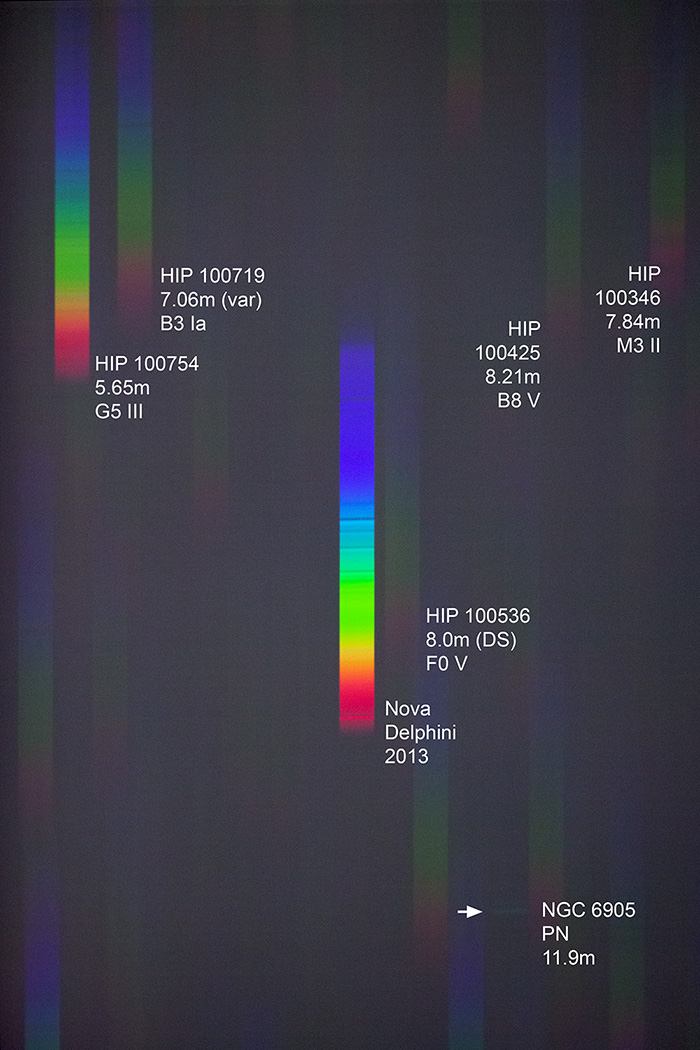 When a new star appeared in the constellation Delphinus late last week, astronomers found its spectrum hinted at the apparition's true nature. Now known as Nova Delphini, its visible light spectrum near maximum brightness is centered in this image of the nearby star field captured with prism and telescope on the night of August 16/17 at the Sternwarte Bülach, Switzerland. Strong absorption lines due to hydrogen atoms are seen as the darkest bands in the nova's spectrum, but the strong absorption lines are bordered along their redward edge by bright bands of emission. That pattern is the spectral signature of material blasted from a catalysmic binary system known as a classical nova. Other stars in field are fainter, identified by their Hipparcus catalog numbers, brightness in magnitudes, and spectral types. By chance, the faint emission line from planetary nebula NGC 6905 was also included, indicated at the lower right.
__________________
1st in Kommisar's 2009 SM Tournament 1st in I Love You`s 2009 New Year`s Tournament 3rd in EnR's Mashfest '08 tournament 5th in Phynx's Unofficial FFR Tournament 9th in D3 of the 2008-2009 4th Official FFR Tournament 10th in D5 of the 2010 5th Official FFR Tournament 10th in D6 of the 2011-2012 6th Official FFR Tournament FMO AAA Count: 71 FGO AAA Count: 10 Bluearrowll = The Canadian player who can not detect awkward patterns. If it's awkward for most people, it's normal for Terry. If the file is difficult but super straight forward, he has issues. If he's AAAing a FGO but then heard that his favorite Hockey team was losing by a point, Hockey > FFR PS: Cool AAA's Terry - I Love You An Alarm Clock's Haiku beep beep beep beep beep beep beep beep beep beep beep beep beep beep beep beep beep - ieatyourlvllol |
|
|

|
|
|
#650 |
|
⊙▃⊙
|
What's in the sky tonight?
August 24, 2013 -The asteroid 7 Iris (the 7th discovered) is just past opposition in Aquarius. -The Sagittarius Teapot and the surrounding rich Milky Way are highest in the south right after dark in late August. The brightest puff of the summer Milky Way seems to rise like steam from the Teapot's spout. All of the labeled objects here are good binocular targets under a dark sky.  Astro Picture of the Day: August 24, 2013 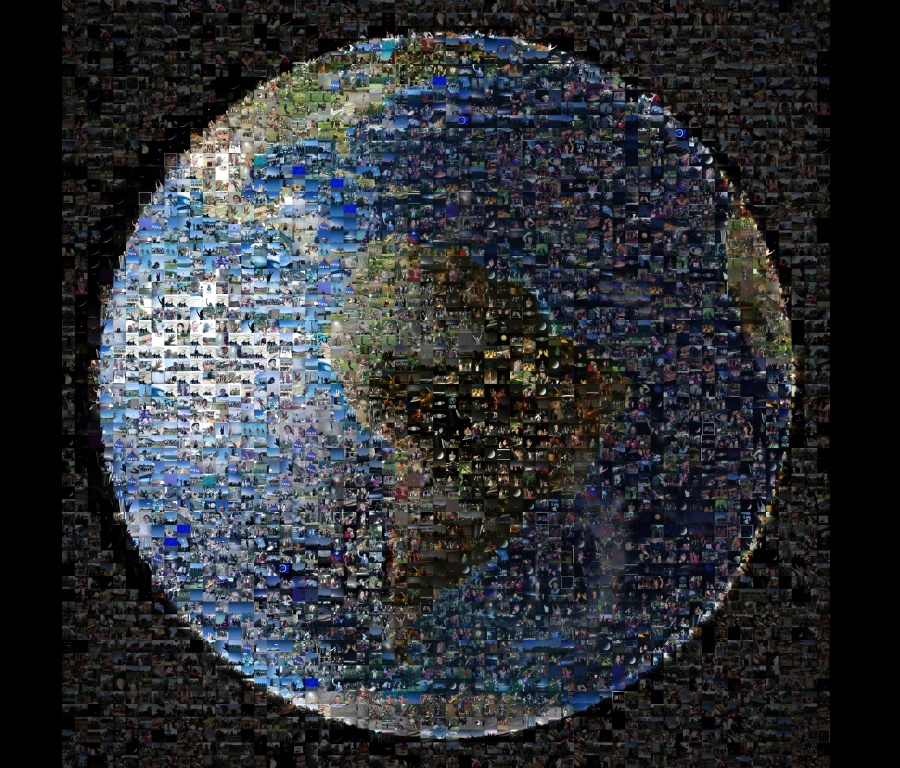 This friendly photo collage is constructed from more than 1,400 images shared by denizens of planet Earth as part of the Cassini Mission's July 19th Wave at Saturn event. The base picture of Earth corresponds to the view from the Saturn-orbiting Cassini spacecraft on that date as its own cameras recorded images including planet Earth as a pale blue dot in the background. Of course, Saturn was 9.65 Astronomical Units away at the time, so it took light from all the waving Earth dwellers just over 80 minutes to travel there. Want to smile? Download and zoom in to the full-resolution (28MB jpg file) collage image available here.
__________________
1st in Kommisar's 2009 SM Tournament 1st in I Love You`s 2009 New Year`s Tournament 3rd in EnR's Mashfest '08 tournament 5th in Phynx's Unofficial FFR Tournament 9th in D3 of the 2008-2009 4th Official FFR Tournament 10th in D5 of the 2010 5th Official FFR Tournament 10th in D6 of the 2011-2012 6th Official FFR Tournament FMO AAA Count: 71 FGO AAA Count: 10 Bluearrowll = The Canadian player who can not detect awkward patterns. If it's awkward for most people, it's normal for Terry. If the file is difficult but super straight forward, he has issues. If he's AAAing a FGO but then heard that his favorite Hockey team was losing by a point, Hockey > FFR PS: Cool AAA's Terry - I Love You An Alarm Clock's Haiku beep beep beep beep beep beep beep beep beep beep beep beep beep beep beep beep beep - ieatyourlvllol |
|
|

|
|
|
#651 |
|
⊙▃⊙
|
What's in the sky tonight?
August 25, 2013 -Whenever bright Vega shines highest overhead, as it's doing after dark this week, you know that Sagittarius, rich in deep-sky objects, is at its highest and best in the south. Do your observing here early before the Moon rises around 10. -NOAA forecasters estimate a 75% chance of polar geomagnetic storms on Aug. 25th in response to an expected CME impact. High-latitude sky watchers should be alert for auroras. Astro Picture of the Day: August 25, 2013 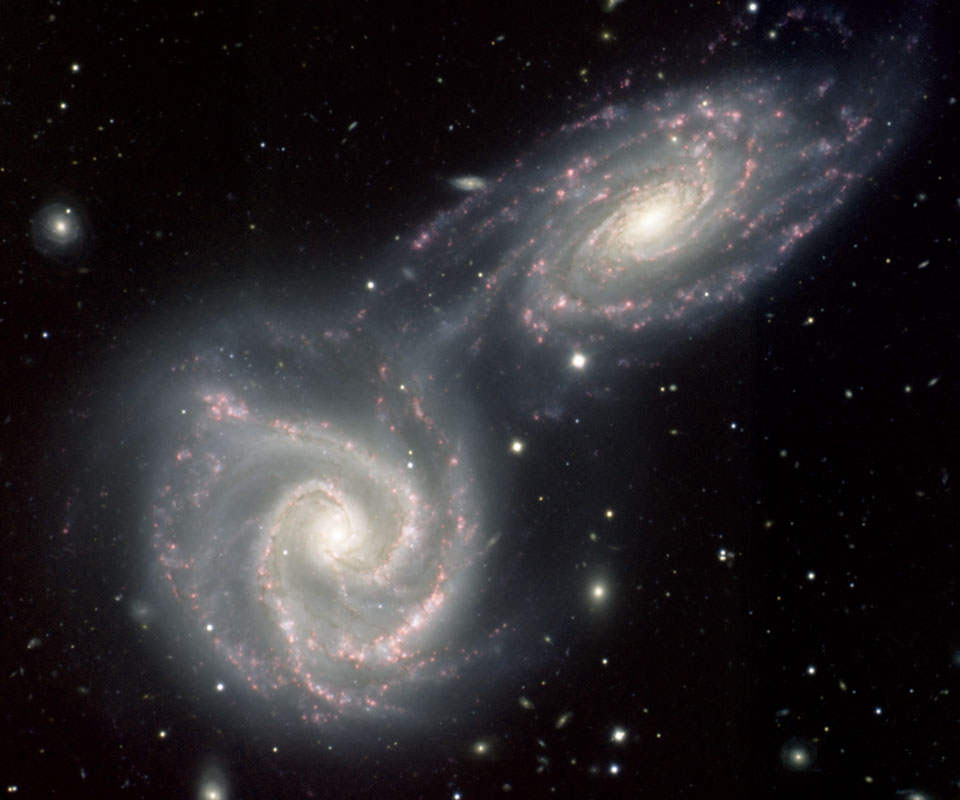 What will become of these galaxies? Spiral galaxies NGC 5426 and NGC 5427 are passing dangerously close to each other, but each is likely to survive this collision. Typically when galaxies collide, a large galaxy eats a much smaller galaxy. In this case, however, the two galaxies are quite similar, each being a sprawling spiral with expansive arms and a compact core. As the galaxies advance over the next tens of millions of years, their component stars are unlikely to collide, although new stars will form in the bunching of gas caused by gravitational tides. Close inspection of the above image taken by the 8-meter Gemini-South Telescope in Chile shows a bridge of material momentarily connecting the two giants. Known collectively as Arp 271, the interacting pair spans about 130,000 light years and lies about 90 million light-years away toward the constellation of Virgo. Recent predictions hold that our Milky Way Galaxy will undergo a similar collision with the neighboring Andromeda Galaxy in a few billion years.
__________________
1st in Kommisar's 2009 SM Tournament 1st in I Love You`s 2009 New Year`s Tournament 3rd in EnR's Mashfest '08 tournament 5th in Phynx's Unofficial FFR Tournament 9th in D3 of the 2008-2009 4th Official FFR Tournament 10th in D5 of the 2010 5th Official FFR Tournament 10th in D6 of the 2011-2012 6th Official FFR Tournament FMO AAA Count: 71 FGO AAA Count: 10 Bluearrowll = The Canadian player who can not detect awkward patterns. If it's awkward for most people, it's normal for Terry. If the file is difficult but super straight forward, he has issues. If he's AAAing a FGO but then heard that his favorite Hockey team was losing by a point, Hockey > FFR PS: Cool AAA's Terry - I Love You An Alarm Clock's Haiku beep beep beep beep beep beep beep beep beep beep beep beep beep beep beep beep beep - ieatyourlvllol |
|
|

|
|
|
#652 |
|
⊙▃⊙
|
What's in the sky tonight?
August 26, 2013 - The Moon rises around 11 p.m. now, about a fist-width at arm's length to the right of the Pleiades. -Perseus is up in good view in the northeast by late evening. By then you can catch Algol, Beta Persei, near the bottom of one of its eclipses: shining at only magnitude 3.4 instead of its usual 2.1. Mid-eclipse is around 11:54 p.m. EDT (8:54 p.m. PDT). Algol stays this dim for about two hours, and it takes several additional hours to fade and to rebrighten. -The double-CME expected to hit Earth's magnetic field over the weekend either is late or missed entirely. In Alaska, the Northern Lights appeared anyway.Even without a CME impact, minor fluctuations in the solar wind were enough to ignite auroras around many parts of the Arctic Circle. Thanks to the waning of the summer midnight sun, the lights were visible for the first time in months. 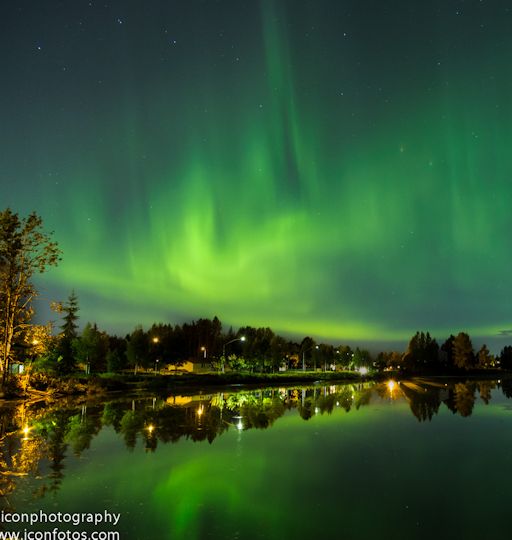 Astro Picture of the Day: August 26, 2013 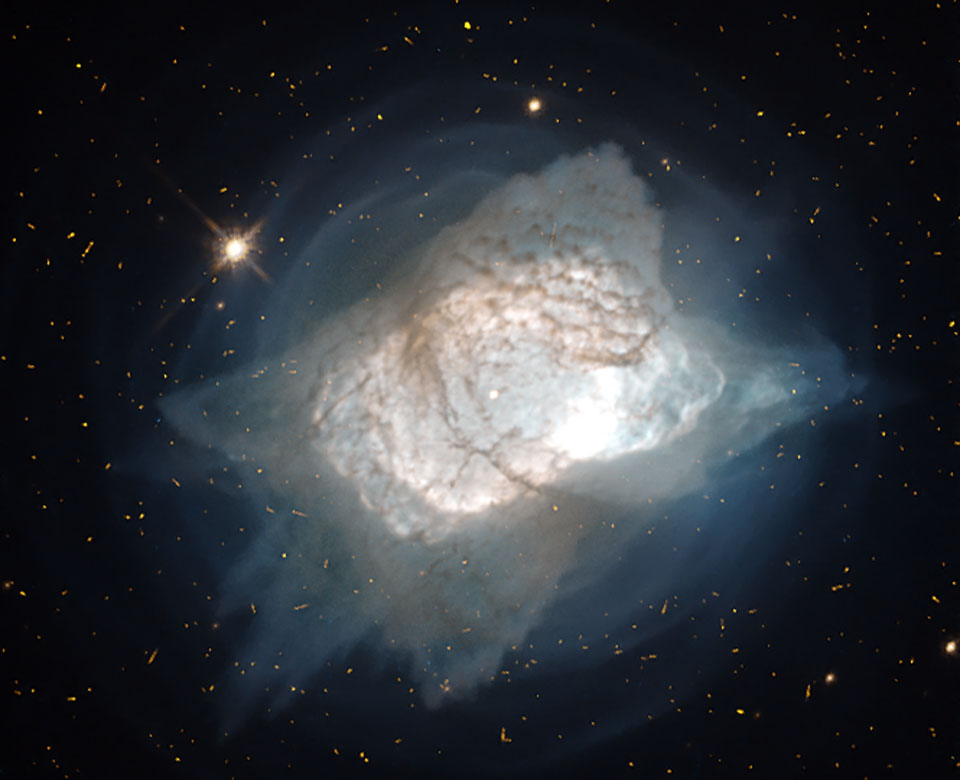 It is one of the brightest planetary nebulae on the sky - what should it be named? First discovered in 1878, nebula NGC 7027 can be seen toward the constellation of the Swan (Cygnus) with a standard backyard telescope. Partly because it appears there as only an indistinct spot, it is rarely referred to with a moniker. When imaged with the Earth-orbiting Hubble Space Telescope, however, great details are revealed. Studying Hubble images of NGC 7027 have led to the understanding that it is a planetary nebula that began expanding about 600 years ago, and that the cloud of gas and dust is unusually massive as it appears to contain about three times the mass of our Sun. Pictured above in assigned colors, the resolved, layered, and dust-laced features of NGC 7027 might remind sky enthusiasts of a familiar icon that could be the basis for an informal name. Please feel free to make suggestions - some suggestions are being recorded, for example, in an online APOD discussion forum found here; http://asterisk.apod.com/viewtopic.php?f=9&t=31990
__________________
1st in Kommisar's 2009 SM Tournament 1st in I Love You`s 2009 New Year`s Tournament 3rd in EnR's Mashfest '08 tournament 5th in Phynx's Unofficial FFR Tournament 9th in D3 of the 2008-2009 4th Official FFR Tournament 10th in D5 of the 2010 5th Official FFR Tournament 10th in D6 of the 2011-2012 6th Official FFR Tournament FMO AAA Count: 71 FGO AAA Count: 10 Bluearrowll = The Canadian player who can not detect awkward patterns. If it's awkward for most people, it's normal for Terry. If the file is difficult but super straight forward, he has issues. If he's AAAing a FGO but then heard that his favorite Hockey team was losing by a point, Hockey > FFR PS: Cool AAA's Terry - I Love You An Alarm Clock's Haiku beep beep beep beep beep beep beep beep beep beep beep beep beep beep beep beep beep - ieatyourlvllol |
|
|

|
|
|
#653 |
|
⊙▃⊙
|
What's in the sky tonight?
August 27, 2013 -Solar activity is low. All of the sunspots on the Earthside of the sun are either stable or decaying. NOAA forecasters estimate no more than a 1% chance of M-class solar flares during the next 24 hours. -Last-quarter Moon tonight (exact at 5:35 a.m. Wednesday morning). The Moon rises around 11 or midnight. Once it's well up in the east, look above it for the Pleiades and below it for orange Aldebaran. Well off to their left shines bright Capella. Astro Picture of the Day: August 27, 2013  To the human eye, a nearby flash of lightning looks blindingly white. But have you ever wondered what colors might emerge if the flash were spread out chromatically, like a rainbow? During a recent thunderstorm in Tarn, France, David Antao decided to find out. "I am an enthusiastic astro-spectroscopist," he says, "so I couldn't resist shooting some spectra." All of the colors of a rainbow are present in the lightning strike, but some colors are stronger than others. Red, green and blue emission lines zig-zag across the spectrum tracing the shape of the original bolt. These colors are mainly due to the recombination of electrons with nitrogen molecules broken apart and ionized by the searing heat of the lightning discharge. Lines from oxygen, hydrogen, and nitrogen oxides are present, too. "By analysing this spectra, it is possible to determine the temprature of the lightning," notes Antao. "I am trying to do this now."
__________________
1st in Kommisar's 2009 SM Tournament 1st in I Love You`s 2009 New Year`s Tournament 3rd in EnR's Mashfest '08 tournament 5th in Phynx's Unofficial FFR Tournament 9th in D3 of the 2008-2009 4th Official FFR Tournament 10th in D5 of the 2010 5th Official FFR Tournament 10th in D6 of the 2011-2012 6th Official FFR Tournament FMO AAA Count: 71 FGO AAA Count: 10 Bluearrowll = The Canadian player who can not detect awkward patterns. If it's awkward for most people, it's normal for Terry. If the file is difficult but super straight forward, he has issues. If he's AAAing a FGO but then heard that his favorite Hockey team was losing by a point, Hockey > FFR PS: Cool AAA's Terry - I Love You An Alarm Clock's Haiku beep beep beep beep beep beep beep beep beep beep beep beep beep beep beep beep beep - ieatyourlvllol |
|
|

|
|
|
#654 |
|
⊙▃⊙
|
What's in the sky tonight?
August 28, 2013 -By about 9 p.m. now (depending on where you live), W-shaped Cassiopeia has risen as high in the northeast as the Big Dipper is in the northwest. Midway between them, and a bit higher, is Polaris. Cassiopeia will grow more ascendant over the Dipper in the coming weeks and months as the seasons turn. -The interplanetary magnetic field (IMF) inside the solar wind began tilting south on August 27th. This condition often sets the stage for polar geomagnetic storms. High-latitude sky watchers should be alert for auroras after nightfall. The display shown last night was captured by Oskar Pettersson of Luleċ, Sweden in the picture shown below. -Magnetic fields in the sun's northern hemisphere have opened up, creating a hole in the sun's upper atmosphere. The August 27th image below from NASA's Solar Dynamics Observatory shows how solar wind is streaming out of the coronal hole. The solar wind stream is heading for Earth, due to arrive on August 30-31. Its impact will not be a major event. Nevertheless, it could spark geomagnetic storms and auroras at high latitudes. This is good news around the Arctic Circle where the midnight sun is setting. Darkening skies will allow auroras to be seen for the first time in months. 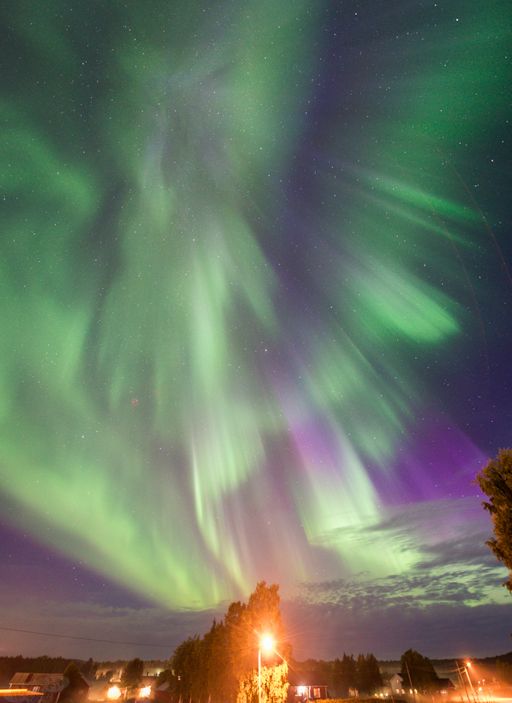 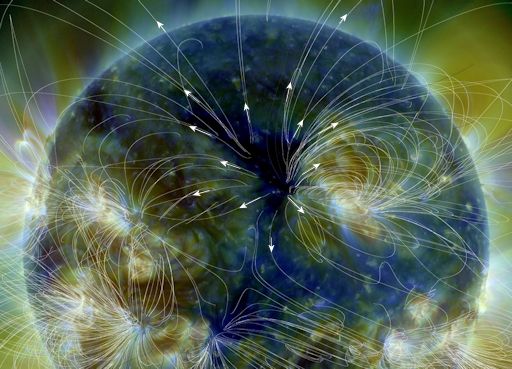 News Posted Today: August 27, 2013 Green Bank Telescope Secures $1 Million Boost  Astro Picture of the Day: August 28, 2013 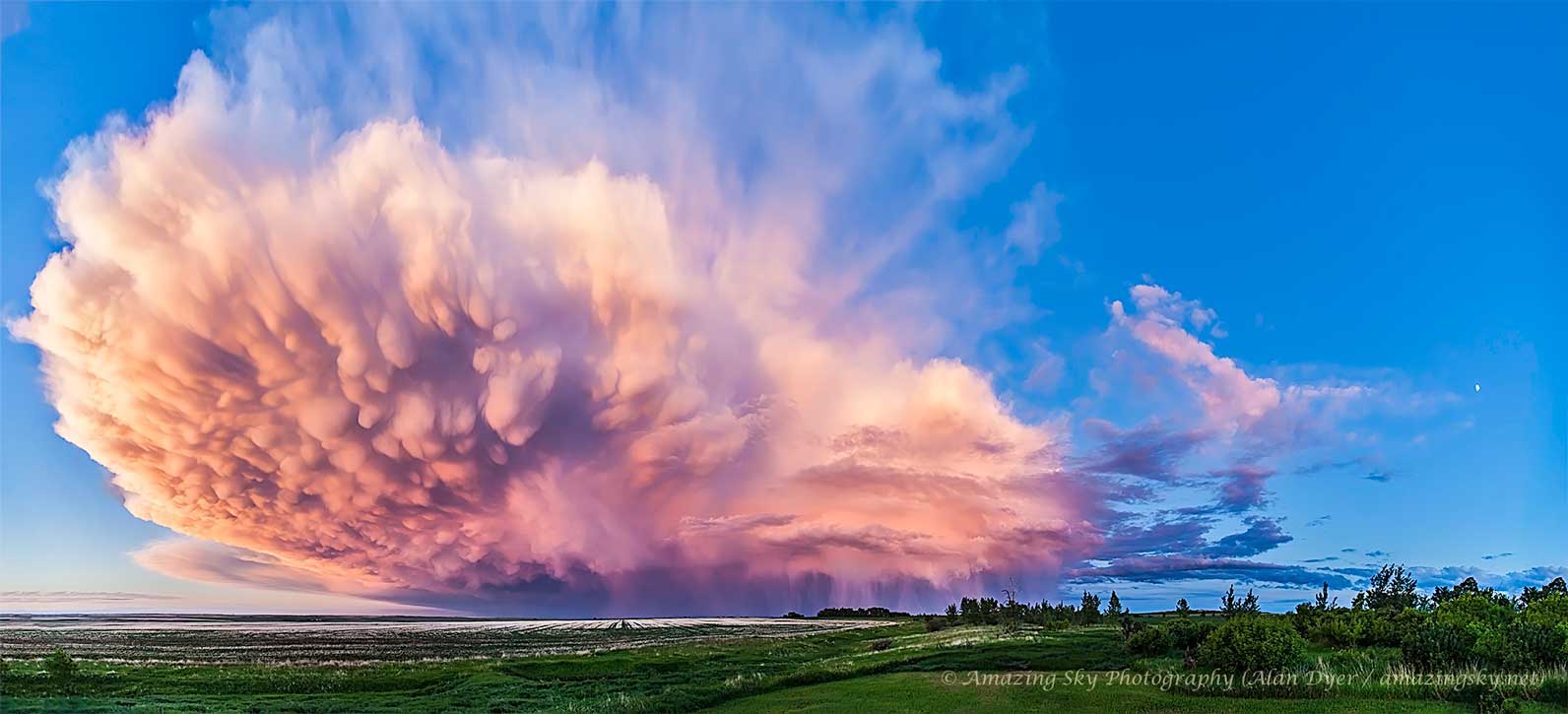 What type of cloud is that? This retreating cumulonimbus cloud, more commonly called a thundercloud, is somewhat unusual as it contains the unusual bumpiness of a mammatus cloud on the near end, while simultaneously producing falling rain on the far end. Taken in mid-June in southern Alberta, Canada, the cloud is moving to the east, into the distance, as the sun sets in the west, behind the camera. In the above image, graphic sunset colors cross the sky to give the already photogenic cloud striking orange and pink hues. A darkening blue sky covers the background. Further in the distance, a rising, waxing, gibbous moon is visible on the far right.
__________________
1st in Kommisar's 2009 SM Tournament 1st in I Love You`s 2009 New Year`s Tournament 3rd in EnR's Mashfest '08 tournament 5th in Phynx's Unofficial FFR Tournament 9th in D3 of the 2008-2009 4th Official FFR Tournament 10th in D5 of the 2010 5th Official FFR Tournament 10th in D6 of the 2011-2012 6th Official FFR Tournament FMO AAA Count: 71 FGO AAA Count: 10 Bluearrowll = The Canadian player who can not detect awkward patterns. If it's awkward for most people, it's normal for Terry. If the file is difficult but super straight forward, he has issues. If he's AAAing a FGO but then heard that his favorite Hockey team was losing by a point, Hockey > FFR PS: Cool AAA's Terry - I Love You An Alarm Clock's Haiku beep beep beep beep beep beep beep beep beep beep beep beep beep beep beep beep beep - ieatyourlvllol |
|
|

|
|
|
#655 |
|
⊙▃⊙
|
What's in the sky tonight?
August 29, 2013 -Mars and Jupiter shine in the east before and during dawn. Jupiter is the highest and brightest (magnitude –2.0). Look for faint Mars (magnitude +1.6) increasingly far to Jupiter's lower left. -Above Mars are Pollux and Castor. Off to its right or lower right twinkles Procyon. -None of the sunspots on the Earthside of the sun is actively flaring. Technically, this means solar activity is "low." Nevertheless, a large magnetic filament in the sun's southern hemisphere erupted during the early hours of August 29th. The CME it hurled into space might have an Earth-directed component. Astro Picture of the Day: August 29, 2013    Since Nova Delphinii erupted on August 14th, it has been photographed by both professional and amateur astronomers. Peaking on August 16th at magnitude 4.5, I became one of the photographers when I captured the Nova in the outskirts of Toronto, although I couldn't physically see it with the amount of lgiht pollution around. Fortunately, cameras have better eyes than I do, and on August 17th I was able to confirm the Nova was around magnitude 4.5 by comparing it to relative stars. This picture is both shown with annotations and without annotations in the first two pictures. Last night on August 28, 2013 from the much darker town of Wasaga Beach, I sought out to capture a much fainter Nova at magnitude 6.3. Using the same amount of stacked images as the previous expedition, the effect of light pollution and the dimming Nova are both clear in the two comparitive pictures. All background stars are notably brighter in the wasaga Beach photos. The best way to note the change in brightness of the Nova is to look at the 'triangle' of roughly equal stars above, and just below to the left and right of the Nova. In the August 17 picture, the Nova is considerably brighter. In the picture from last night, they appear roughly the same. The light curve below shows the gradual dimming of the Nova since the peak. 
__________________
1st in Kommisar's 2009 SM Tournament 1st in I Love You`s 2009 New Year`s Tournament 3rd in EnR's Mashfest '08 tournament 5th in Phynx's Unofficial FFR Tournament 9th in D3 of the 2008-2009 4th Official FFR Tournament 10th in D5 of the 2010 5th Official FFR Tournament 10th in D6 of the 2011-2012 6th Official FFR Tournament FMO AAA Count: 71 FGO AAA Count: 10 Bluearrowll = The Canadian player who can not detect awkward patterns. If it's awkward for most people, it's normal for Terry. If the file is difficult but super straight forward, he has issues. If he's AAAing a FGO but then heard that his favorite Hockey team was losing by a point, Hockey > FFR PS: Cool AAA's Terry - I Love You An Alarm Clock's Haiku beep beep beep beep beep beep beep beep beep beep beep beep beep beep beep beep beep - ieatyourlvllol |
|
|

|
|
|
#656 |
|
⊙▃⊙
|
What's in the sky tonight?
August 30, 2013 -Before dawn tomorrow morning, Jupiter shines to the left of the waning crescent Moon. They're in Gemini in the east, as shown here. Look for Orion way off to their right. -NASA's Meteoroid Environment Office has upgraded its estimates of a major fireball that exploded over the southeastern USA on August 28th. Lead researcher Bill Cooke says " the fireball reached a peak magnitude of -13, brighter than a Full Moon, and cast shadows on the ground. This indicates that the meteoroid had a mass of over 50 kg (110 lbs) and was about 40 cm (16 inches) in diameter. It hit the top of Earth's atmosphere traveling 23.7 km/s (53,000 mph)." "As far as I know, this is the brightest event our network has observed in 5 years of operation," he continues. "There are reports of sonic booms reaching the ground, and data from 4 doppler radars indicate that some meteorites may have fallen along the fireball's ground track." (Note: The city in the ground track map is Cleveland, Tennessee, not Cleveland, Ohio.) -Using data from multiple cameras, Cooke has calculated a preliminary orbit for the meteoroid. The shape and dimensions of the orbit are similar those of a Jupiter-family comet. If meteorites are recovered from the Tennessee countryside, their chemical composition will tell researchers more about the origin of the fireball. A video of the fireball can be found here: http://spaceweather.com/images2013/2...72724B_02A.wmv Astro Picture of the Day: August 30, 2013 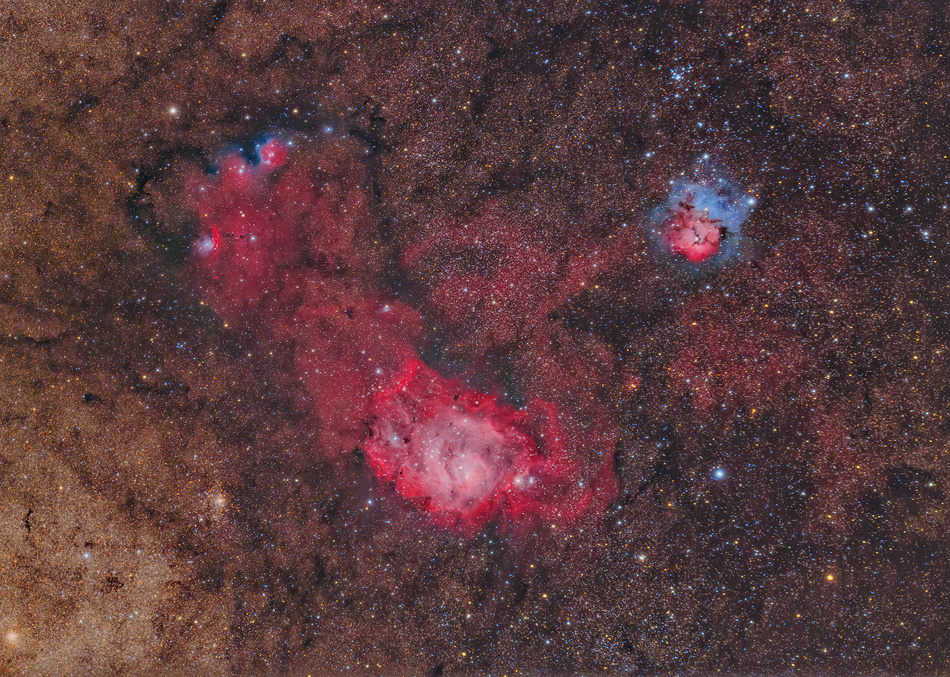 These three bright nebulae are often featured in telescopic tours of the constellation Sagittarius and the crowded starfields of the central Milky Way. In fact, 18th century cosmic tourist Charles Messier cataloged two of them; M8, the large nebula left of center, and colorful M20 on the right. The third, NGC 6559, is above M8, separated from the larger nebula by a dark dust lane. All three are stellar nurseries about five thousand light-years or so distant. The expansive M8, over a hundred light-years across, is also known as the Lagoon Nebula. M20's popular moniker is the Trifid. Glowing hydrogen gas creates the dominant red color of the emission nebulae, with contrasting blue hues, most striking in the Trifid, due to dust reflected starlight. The colorful skyscape recorded with telescope and digital camera also includes one of Messier's open star clusters, M21, just above the Trifid.
__________________
1st in Kommisar's 2009 SM Tournament 1st in I Love You`s 2009 New Year`s Tournament 3rd in EnR's Mashfest '08 tournament 5th in Phynx's Unofficial FFR Tournament 9th in D3 of the 2008-2009 4th Official FFR Tournament 10th in D5 of the 2010 5th Official FFR Tournament 10th in D6 of the 2011-2012 6th Official FFR Tournament FMO AAA Count: 71 FGO AAA Count: 10 Bluearrowll = The Canadian player who can not detect awkward patterns. If it's awkward for most people, it's normal for Terry. If the file is difficult but super straight forward, he has issues. If he's AAAing a FGO but then heard that his favorite Hockey team was losing by a point, Hockey > FFR PS: Cool AAA's Terry - I Love You An Alarm Clock's Haiku beep beep beep beep beep beep beep beep beep beep beep beep beep beep beep beep beep - ieatyourlvllol |
|
|

|
|
|
#657 |
|
⊙▃⊙
|
What's in the sky tonight?
August 31, 2013 -Before dawn Sunday morning, the waning Moon shines inside a quadrilateral of Pollux, Jupiter, Mars, and Procyon, as shown below. -A coronal mass ejection is expected to hit Earth's magnetic field on Sept. 1st, sparking minor to moderate geomagnetic storms around the poles. The CME was propelled toward Earth by a C8-class flare from sunspot AR1836 on August 30th. High-latitude sky watchers, be alert for auroras!  Astro Picture of the Day: August 31, 2013 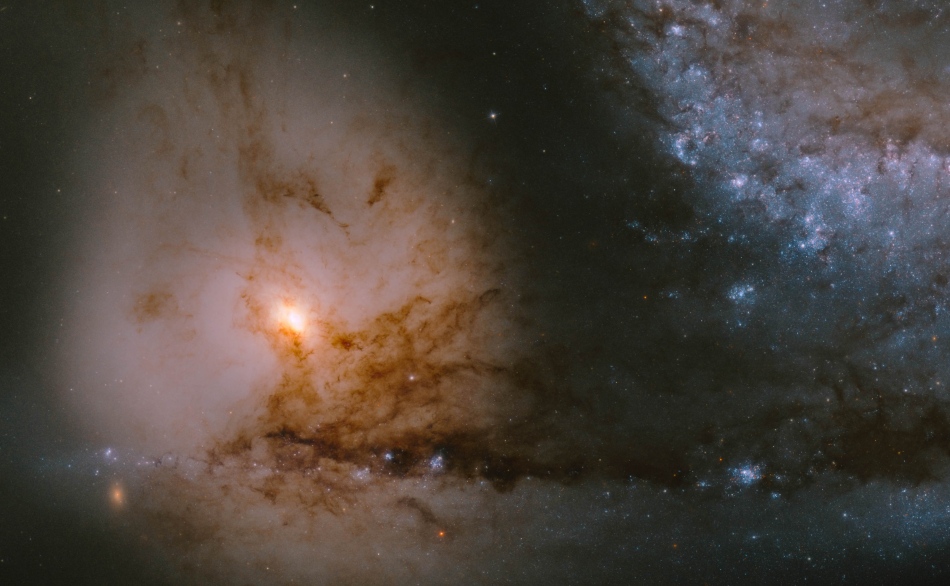 Dwarf galaxy NGC 5195 is best known as the smaller companion of spiral M51, the Whirlpool galaxy. Seen together they seem to trace the curve and dot of a cosmic question mark, recorded in Lord Rosse's 19th century drawings as one of the original spiral nebulae. Dwarfed by enormous M51 (aka NGC 5194), NGC 5195 spans about 20,000 light-years. A close encounter with M51 has likely triggered star formation and enhanced that galaxy's prominent spiral arms. Processed from image data available in the Hubble Legacy Archive, this majestic close-up of NGC 5195 makes it clear that the dwarf galaxy now lies behind M51. A tidal bridge of dark dust clouds and young blue star clusters stretches from the outskirts of M51 on the right, appearing in silhouette against the dwarf galaxy's yellowish glow. The famous pair of interacting galaxies lie some 30 million light-years away, toward the handle of the Big Dipper, and the constellation of the Hunting Dogs.
__________________
1st in Kommisar's 2009 SM Tournament 1st in I Love You`s 2009 New Year`s Tournament 3rd in EnR's Mashfest '08 tournament 5th in Phynx's Unofficial FFR Tournament 9th in D3 of the 2008-2009 4th Official FFR Tournament 10th in D5 of the 2010 5th Official FFR Tournament 10th in D6 of the 2011-2012 6th Official FFR Tournament FMO AAA Count: 71 FGO AAA Count: 10 Bluearrowll = The Canadian player who can not detect awkward patterns. If it's awkward for most people, it's normal for Terry. If the file is difficult but super straight forward, he has issues. If he's AAAing a FGO but then heard that his favorite Hockey team was losing by a point, Hockey > FFR PS: Cool AAA's Terry - I Love You An Alarm Clock's Haiku beep beep beep beep beep beep beep beep beep beep beep beep beep beep beep beep beep - ieatyourlvllol |
|
|

|
|
|
#658 |
|
⊙▃⊙
|
What's in the sky tonight?
September 1, 2013 -NOAA forecasters estimate a 70% chance of polar geomagnetic storms on Sept. 1st when a CME is expected to hit Earth's magnetic field. High-latitude sky watchers should be alert for auroras. -Look east after dark for the Great Square of Pegasus balancing on one corner. Its stars are 2nd and 3rd magnitude. From the Square's left corner runs Andromeda's main line of 2nd-magnitude stars, similarly spaced.  Astro Picture of the Day: September 1, 2013 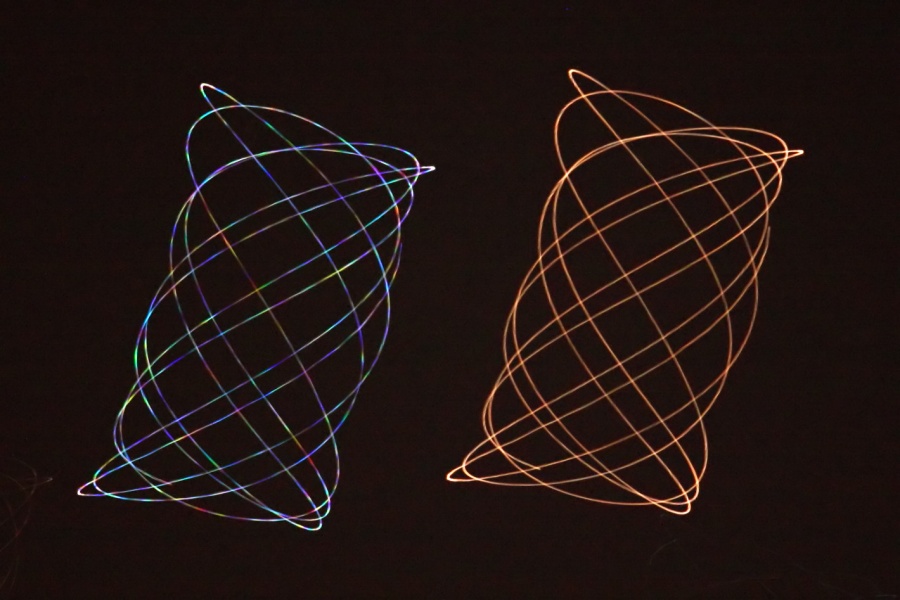 On June 4, 2010 Regulus, alpha star of the constellation Leo, and wandering planet Mars were at about the same apparent brightness, separated on the sky by 1.5 degrees. An ingenious and creative 10 second exposure from a swinging camera recorded these gyrating trails of the celestial pairing. Can you tell which trail belongs to the star and which to the planet? Hint: atmospheric turbulence causes the image of the star to scintillate or vary in brightness and color more readily than the planet. The scintillation is more pronounced because the star is effectively a point source of light seen as a narrow bundle of light rays. Rapidly changing refraction due to turbulence along the line of sight affects different colors of light by different amounts and generally produces a twinkling effect for stars. But Mars is much closer than the distant stars and an extended source of light. Though tiny, its disk is seen as a bundle of light rays that is substantially broader compared to a star's and so, on average, less affected by small scale turbulence. The result is the varied, rainbow like trail for Regulus (left) and the steadier, consistently reddish trail for Mars.
__________________
1st in Kommisar's 2009 SM Tournament 1st in I Love You`s 2009 New Year`s Tournament 3rd in EnR's Mashfest '08 tournament 5th in Phynx's Unofficial FFR Tournament 9th in D3 of the 2008-2009 4th Official FFR Tournament 10th in D5 of the 2010 5th Official FFR Tournament 10th in D6 of the 2011-2012 6th Official FFR Tournament FMO AAA Count: 71 FGO AAA Count: 10 Bluearrowll = The Canadian player who can not detect awkward patterns. If it's awkward for most people, it's normal for Terry. If the file is difficult but super straight forward, he has issues. If he's AAAing a FGO but then heard that his favorite Hockey team was losing by a point, Hockey > FFR PS: Cool AAA's Terry - I Love You An Alarm Clock's Haiku beep beep beep beep beep beep beep beep beep beep beep beep beep beep beep beep beep - ieatyourlvllol |
|
|

|
|
|
#659 |
|
⊙▃⊙
|
What's in the sky tonight?
September 2, 2013 -Right after dark at this time of year, bright Vega shines almost straight overhead for skywatchers at mid-northern latitudes. Whenever Vega is highest, it's the sign that rich Sagittarius is at its highest in the south. Work through the Sagittarius area with your charts and scope before it sinks low for the night and the season. -The Sagittarius Teapot and the surrounding rich Milky Way are highest in the south right after dark at this time of year. The brightest puff of the summer Milky Way seems to rise like steam from the Teapot's spout. All of the labeled objects here and many more are good binocular targets under a dark sky. -The US Air Force Space Surveillance Radar or "Space Fence" has stopped transmitting. "It appears they pulled the plug at 00:00 UT (6 am Local MDT) on September 1st," reports engineer Stan Nelson, who has been monitoring the radar using an antenna in Roswell, New Mexico. The shutdown is a result of sequester budget cuts by the US Congress. The radar's final echoes came from a Russian satellite and a sporadic meteor. http://spaceweather.com/gallery/indi...pload_id=86224   News Posted Today: September 1, 2013 Sun Loses Lithium with Age  Astro Picture of the Day: September 2, 2013   What's that below the Milky Way? First, across the top of the above image, lies the faint band that is our planet's sideways view of the central disk of our home Milky Way Galaxy. The Milky Way band can be seen most clear nights from just about anywhere on Earth with a dark sky. What lies beneath is, by comparison, is a much less common sight. It is the striking peak of Castildetierra, a rock formation located in Bardenas Reales, a natural badlands in northeast Spain. Standing 50 meters tall, the rock spire includes clay and sandstone left over from thousands of years of erosion by wind and water. The astrophotographer waited months for the sky to appear just right - and then took the 14 exposures that compose the above image in a single night.
__________________
1st in Kommisar's 2009 SM Tournament 1st in I Love You`s 2009 New Year`s Tournament 3rd in EnR's Mashfest '08 tournament 5th in Phynx's Unofficial FFR Tournament 9th in D3 of the 2008-2009 4th Official FFR Tournament 10th in D5 of the 2010 5th Official FFR Tournament 10th in D6 of the 2011-2012 6th Official FFR Tournament FMO AAA Count: 71 FGO AAA Count: 10 Bluearrowll = The Canadian player who can not detect awkward patterns. If it's awkward for most people, it's normal for Terry. If the file is difficult but super straight forward, he has issues. If he's AAAing a FGO but then heard that his favorite Hockey team was losing by a point, Hockey > FFR PS: Cool AAA's Terry - I Love You An Alarm Clock's Haiku beep beep beep beep beep beep beep beep beep beep beep beep beep beep beep beep beep - ieatyourlvllol |
|
|

|
|
|
#660 |
|
⊙▃⊙
|
What's in the sky tonight?
September 3, 2013 -With the Moon out of the evening sky, now's a good time to see what you can make of the distant galaxy cluster Abell 2666. Its location is easy to find just inside the Great Square of Pegasus. But you'll need a moderately large telescope and a good sky; the cluster's brightest member, giant NGC 7768, appears 12th or 13th magnitude. If you succeed, could this be your record-farthest galaxy? The cluster is 300 million light-years away. -The Earthside of the sun is quiet and stable today. NOAA forecasters estimate a slim 5% chance of M-class solar flares. The most likely source of an eruption would be sunspot AR1836, which is directly facing Earth. -A CME expected to hit Earth's magnetic field over the weekend is either late or it hit with such weak impact that solar wind signatures barely show its arrival. Nevertheless, auroras did appear around the Arctic Circle on Sept. 1st and 2nd.   News Posted Today: September 2, 2013 An Annular Eclipse on Mars  Astro Picture of the Day: September 3, 2013  Here lie familiar shapes in unfamiliar locations. On the left is an emission nebula cataloged as NGC 7000, famous partly because it resembles our fair planet's continent of North America. The emission region to the right of the North America Nebula is IC 5070, also known for its suggestive outlines as the Pelican Nebula. Separated by a dark cloud of obscuring dust, the two bright nebulae are about 1,500 light-years away. At that distance, the 4 degree wide field of view spans 100 light-years. This spectacular cosmic portrait combines narrow band images to highlight bright ionization fronts with fine details of dark, dusty forms in silhouette. Emission from atomic hydrogen, sulfur, and oxygen is captured in the narrow band data. These nebulae can be seen with binoculars from a dark location. Look northeast of bright star Deneb in the constellation of Cygnus the Swan.
__________________
1st in Kommisar's 2009 SM Tournament 1st in I Love You`s 2009 New Year`s Tournament 3rd in EnR's Mashfest '08 tournament 5th in Phynx's Unofficial FFR Tournament 9th in D3 of the 2008-2009 4th Official FFR Tournament 10th in D5 of the 2010 5th Official FFR Tournament 10th in D6 of the 2011-2012 6th Official FFR Tournament FMO AAA Count: 71 FGO AAA Count: 10 Bluearrowll = The Canadian player who can not detect awkward patterns. If it's awkward for most people, it's normal for Terry. If the file is difficult but super straight forward, he has issues. If he's AAAing a FGO but then heard that his favorite Hockey team was losing by a point, Hockey > FFR PS: Cool AAA's Terry - I Love You An Alarm Clock's Haiku beep beep beep beep beep beep beep beep beep beep beep beep beep beep beep beep beep - ieatyourlvllol |
|
|

|
 |
| Currently Active Users Viewing This Thread: 1 (0 members and 1 guests) | |
|
|